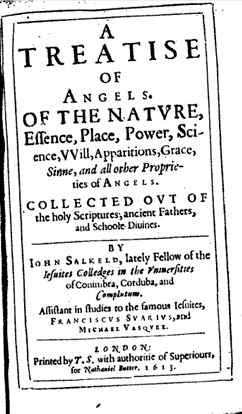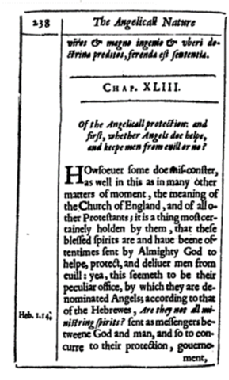A Treatise of Angels
In John Salkeld’s A Treatise of Angels we can see that angels played a variety of roles in the lives of early modern Christians, such as messenger and protector. We get an insight into angels’ multifaceted nature, and how this was perceived by early modern people themselves.
The treatise was first published in London in 1613, at a time when the nature of the supernatural world had fallen under fresh scrutiny, thanks in part to the strong beliefs of King James VI and I. The King James Bible was published only two years prior to Salkeld’s work, with the translators aiming to address perceived errors in earlier English versions. This was significant as it marked a desire to make an accurate version of God’s teachings accessible to anyone who could read English, or who knew someone who did.
Salkeld was a Protestant who had converted from Catholicism, and we can see this inner conflict in his work [1]. The fact that he wrote a book on angels at all was potentially problematic. Protestants saw God as a supreme power, and criticised Catholics for praying to saints or angelic intermediaries, seeing this as detracting from the omnipotence of God. However, throughout this work, Salkeld emphasises the role of the angels as extensions of God, trying to reconcile their existence with the strict rules of Protestantism [2].
Angels’ primary role in early modern texts is that of messengers, following the biblical template of Gabriel. Salkeld claimed that angels were ‘ministering spirits’ who were ‘sent as messengers between God and man’ (p. 238). This role is consistent with other literature; in Shakespeare’s Romeo and Juliet (1597), Romeo compares Juliet to a ‘winged messenger of heaven’ [3]. Also, in the 1702 New English Dictionary of John Kersey the Younger, an angel is defined as ‘a messenger from Heaven’ [4]. This suggests to us that early modern English people conceived of angels first and foremost as message-carriers between God and humanity, with any other roles, like protector, coming second to this [5].
Salkeld suggested that angels would ‘helpe, protect, and deliver men from evill’, showing us that many believed angels were at work in their daily lives (p. 238). He used examples of Bible stories about both Daniel and David to show how angels supported and defended humans in the past (pp. 240-1, 244). We can also see examples of this belief through other contemporary media, including popular pamphlets and Shakespeare’s Hamlet (written c. 1600), in which Hamlet exclaims ‘Angels and ministers of grace defend us!’ Protestant theologians commonly doubted that humans had guardian angels, and James VI and I’s 1597 Daemonologie underlined the Protestant orthodoxy that angels had stopped appearing on earth once Christianity was established, but the idea of angels as protectors remained culturally important [6].
Nonetheless, God was still the supreme power. Songs, hymns and stories petitioned for the assistance of angels, but only by the grace of God [7]. Salkeld framed angels as sent out as ‘the bounty and love of God towards man’, rather than as independent entities (p. 248). Salkeld sought to appease Protestant theologians by using angels to show the ‘infinite nature of God’s resources’, and viewing them as an extension of God himself [8].
Overall, this source emphasises how God used angels for many purposes, and we can see that angels took on multiple roles, such as messenger and protector. However, this happened strictly through the power of God. Salkeld’s text represents an attempt to reconcile deep-rooted societal beliefs about the roles of angels with the orthodox Protestant mistrust of supernatural intermediaries.
By Anna Sharp
[1] Rowland S Ward, God and Adam: Reformed Theology and the Creation Covenant (Wantirna: New Melbourne Press, 2003), p. 52.
[2] On these rules, see Jane Shaw, Miracles in Enlightenment England (New Haven: Yale University Press, 2006).
[3] William Shakespeare, Romeo and Juliet (1597), Act II Scene i.
[4] Laura Sangha, Angels and Belief in England, 1480-1700 (London: Pickering & Chatto, 2012), p. 147.
[5] Alexandra Walsham, ‘Invisible Helpers: Angelic Intervention in Post-Reformation England’, Past & Present 208 (2010), 77-130, at p. 122.
[6] James VI, Daemonologie, in Neil Rhodes, Jennifer Richards and Joseph Marshall (eds), King James VI and I: Selected Writings (Aldershot: Ashgate, 2003): 149-97, bk. 2, chap. 7, p. 188.
[7] Sangha, Angels and Belief in England, p. 166.
[8] Euan Cameron, ‘Angels, Demons and Everything in Between: Spiritual Beings in Early Modern Europe’, in Clare Copeland and Jan Machielsen (eds), Angels of Light? Sanctity and the Discernment of Spirits in the Early Modern Period (Leiden: Brill, 2012), p. 37.

John Salkeld, A Treatise of Angels (London, 1613), title page

John Salkeld, A Treatise of Angels (London, 1613), p. 238
